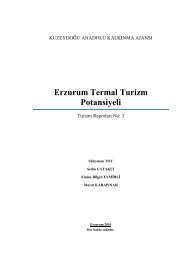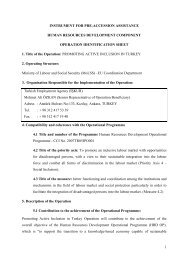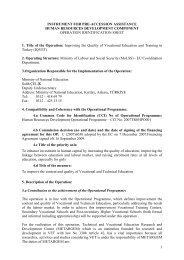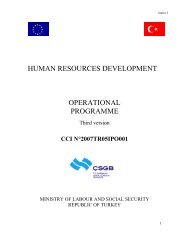HRD Operational Programme (5.1) İKG Hibe ve Tanıtım (5.2, 5.3)
HRD Operational Programme (5.1) İKG Hibe ve Tanıtım (5.2, 5.3)
HRD Operational Programme (5.1) İKG Hibe ve Tanıtım (5.2, 5.3)
You also want an ePaper? Increase the reach of your titles
YUMPU automatically turns print PDFs into web optimized ePapers that Google loves.
İnsan Kaynaklarının Geliştirilmesi Haber Bülteni Human Resources De<strong>ve</strong>lopment Newsletter<br />
1- What is really meant by saying “Human Resources De<strong>ve</strong>leopment”? What kind of link can we<br />
establish between the EU process and Human Resources?<br />
When comparing Turkey and EU member states, certain differences in indicators regarding human<br />
resources are worth attention. We see that we face more negati<strong>ve</strong> conditions than the EU with<br />
respect to participation in labour force and employment rates, education and vocational training<br />
indicators, and powerty rates. Although significant impro<strong>ve</strong>ments ha<strong>ve</strong> been achie<strong>ve</strong>d in the recent<br />
years, taking into consideration these indicators, we can say that there are many areas that still<br />
ha<strong>ve</strong> to be impro<strong>ve</strong>d. Of course, it should be said as well that efforts made in these areas shall<br />
render positi<strong>ve</strong> results on the long-term. In spite of these indicators, we should not forget that<br />
Turkey has a <strong>ve</strong>ry important advantage. This advantage is the pool of young human resources.<br />
Turkey is able to use this advantage for a long period. Now we ha<strong>ve</strong> one positi<strong>ve</strong> and one negati<strong>ve</strong><br />
basic fact that we ha<strong>ve</strong> to face. Both of them shall maintain to be valid in the medium-long and<br />
long term. At this point, we need to take a step to identify and implement a correct and long term<br />
“human resources” strategy. This strategy can be summarized as immediately mobilizing our<br />
human resources potential and to find a long-term solution for our basic problems. Exactly at<br />
this point, we ha<strong>ve</strong> started an activity jointly conducted by our Ministry and the relevant bodies of<br />
the European Union and ha<strong>ve</strong> prepared a strategy document together with the concerned public<br />
institutions and establishments. This strategy document should not be seen as a kind of “wish<br />
list”. Because this strategy document includes an action plan, with a time table for the actions to<br />
be taken, a budget, a monitoring and assessment system, a group of people assigned for these<br />
tasks as well as a scope, method and location for these tasks. We call this strategy document the<br />
“Human Resources De<strong>ve</strong>lopment <strong>Operational</strong> <strong>Programme</strong> - <strong>HRD</strong> OP”. We ha<strong>ve</strong> defined three focus<br />
areas in this strategy document. These are education, employment and social inclusion. Each of<br />
these areas shall be subdivided in areas which require combat.<br />
2- So, that means that the identified priority areas ha<strong>ve</strong> been subdivided and the combat areas<br />
ha<strong>ve</strong> increased. According to which criteria and in what way is this classificaton going to happen?<br />
Could you please explain this in a more detailed way?<br />
As I said before, we shall interfere in three basic areas. Employment, Education and Social<br />
Inclusion. Each of these ha<strong>ve</strong> their own subdivisions. The question is according to which criteria?<br />
Let’s explain it by taking the indicators of the Employment priority. When comparing the a<strong>ve</strong>rages<br />
of Turkey and the EU, we see that our employment rate is low, our participation in labour is low<br />
and our unemployment is relativly high. In this context, the annual unemployment rates for 2010<br />
has been calculated as 9.6% for EU member states and 11.9% for our country. On the other hand,<br />
the employment rate for the same year was 43% in Turkey, while it was 64.8% in the third quarter<br />
of 2010 in the European Union. Taking into consideration the annual indicators, the participation<br />
in labour force was 48.8% in 2010 for Turkey, while it was 77.2% in the third quarter of 2010 in the<br />
European Union. Then, where do these differences deri<strong>ve</strong> from? Mainly because the participation<br />
and employment of women in labour force is low, the employment of young people is low and the<br />
provison of employment services are insufficient. For example, the participation in labour force for<br />
women in 2010 was 27.6% and the employment rate was 24%. These indicators re<strong>ve</strong>al the necessity<br />
to identify specific areas under this priority such as the impro<strong>ve</strong>ment of women employment, the<br />
impro<strong>ve</strong>ment of youth employment, and the combat with unregistered employment. In this way,<br />
the areas that need to be impro<strong>ve</strong>d and that require projects under the priority area of employment<br />
are being identified.<br />
3- Could you please gi<strong>ve</strong> some brief information about the financial structure of the Human<br />
Resources De<strong>ve</strong>lopment <strong>Operational</strong> <strong>Programme</strong>? What is the amount of this budget?<br />
15% of the budget of the <strong>HRD</strong> <strong>Operational</strong> Programe is financed by Turkey and 85% by the EU. This<br />
budget, which has started to been used as of 2010, totals 352.588.241 Euros. From this budget a<br />
fund of 15<strong>5.1</strong>38.825 million Euros has been allocated for the employment measure, 109.094.118<br />
Euros for the education measure and 67.200.001 Euros for the social inclusion measure. In order to<br />
be able to efficiently manage the projects that are implemented with IPA funds allocated under the<br />
framework of <strong>HRD</strong> OP, Technical assistance has been identified as another priority area and under<br />
this framework it is aimed at de<strong>ve</strong>loping, implementing, evaluating, monitoring and controlling the<br />
projects. The fund allocated for this purpose is 21.15<strong>5.2</strong>97 Euros.<br />
4- To what extent shall local initiati<strong>ve</strong>s be invol<strong>ve</strong>d? Are there locally implemented projects in<br />
the context of <strong>HRD</strong> OP?<br />
The <strong>HRD</strong> OP fund is being used through grant projects carried out by nationwide public institutions,<br />
local municipalities, uni<strong>ve</strong>rsities, NGO’s and trade unions.Currently, there are 431 grant projects in<br />
implementation. At least one project is being implemented in 38 out of the 43 provinces in 12 NUTS II<br />
regions which ha<strong>ve</strong> an a<strong>ve</strong>rage GDP per capita that is 75% lower than the Turkey a<strong>ve</strong>rage. Vocational<br />
trainings are being organized to enable the employment of the individuals in the implementation<br />
regions within the scope of the grant projects. Consequently, the human resources in the selected<br />
regions are impro<strong>ve</strong>d. To gi<strong>ve</strong> an example, within the scope of strenghtening Youth Employment<br />
there is a grant project implemented in Sivas for which 20 umemployed young people shall be<br />
provided a training on foreign language, public relations, communication, vocational de<strong>ve</strong>lopment,<br />
front office management, computer skills and reception for a period of 7 months. Within the scope<br />
of strenghtening women employment there are two separate projects implemented in Kayseri for<br />
which 100 women shall be provided training on nursing and textile. There is a project to increase<br />
the school enrollment rate of girls in Hakkari. Similarly, it is possible to obser<strong>ve</strong> many other<br />
successful grant projects in other provinces. These are just some examples that I recall at the<br />
moment.<br />
5- What do you plan under the heading of employment? Are you going to establish cooperation<br />
with other institutions?<br />
Under the heading of employment, we ha<strong>ve</strong> implemented certain measures for the impro<strong>ve</strong>ment of<br />
women’s participation in the labour force, strengthening youth employment, improving registered<br />
employment, and strengthening the quality of employment services mainly targeting those<br />
migrating from the villages to the cities. A budget has been planned totalling 155 million Euros for<br />
activities in this area. We will provide that most of this budget shall be used for the grant project<br />
by the municipalities, uni<strong>ve</strong>rsities, NGO’s and many other institutions and establishments in the<br />
identified provinces. We shall be in cooperation with İŞKUR and the Social Security Institution when<br />
realizing all of this.<br />
6- Could you please explain the concept of “Social Inclusion”?<br />
Social Inclusion is a concept that has been started to be used recently. It has come to the fore with<br />
a strategy de<strong>ve</strong>loped by the European Union. The objecti<strong>ve</strong> of this strategy is to enable a better<br />
participation in social and economic life for poor individuals and the so-called disadvantaged<br />
individuals and groups who experience various difficulties in participation in social and economic<br />
life. In this context we can list the handicapped, former imprisoned and convicted persons, narcotic<br />
addicts, those who are under the risk of po<strong>ve</strong>rty, poor people mainly living in shantytowns, Romany<br />
citizens and many other citizens who face difficulties in participating in our social and economic<br />
life. Under the framework of social inclusion all parties of the society ha<strong>ve</strong> their responsibilities.<br />
This means that along with public institutions trade unions, NGO’s, uni<strong>ve</strong>rsities, in summary all the<br />
sectors of the society should act together and try to facilitate the participation of the disadvantaged<br />
in social and economic life. It is possible to describe our aim for the priority of social inclusion<br />
under the scope of <strong>HRD</strong> OP as “ facilitating the inclusion of the disadvantaged into our labour<br />
force, to eliminate the obstacles in he labour market and to promote a labour market that includes<br />
e<strong>ve</strong>ryone”. For this purpose we conduct activities aiming at increasing the employability of the<br />
disadvantaged, facilitating their access to the labour market, and eliminating the obstacles for<br />
their entrance in the labour market as well as establishing a better functionality and coordination<br />
between the institutions and mechanisms acti<strong>ve</strong> in the area of labour market and social protection.<br />
A budget totalling 67 million Euros has been allocated for projects to be implemented in this area..<br />
7- What are the plannings for training?<br />
The principal objecti<strong>ve</strong> of the <strong>Operational</strong> <strong>Programme</strong> is to provide an efficiently functioning labour<br />
market in Turkey. Thus, we can say that <strong>HRD</strong> OP has an employment focused approach. Under the<br />
education priority, the objecti<strong>ve</strong> is to strengthen the link between employment and education. To<br />
achie<strong>ve</strong> this objecti<strong>ve</strong>, Operations ha<strong>ve</strong> been designed aiming at increasing the school enrollment<br />
of girls, increasing the quality of vocational training, establishing the culture of lifelong learning<br />
and increasing the adaptation of employees, enterpreneurs and businesses to the changing labour<br />
force market and as of 2010 some of these Operations ha<strong>ve</strong> been started. In the coming period,<br />
other Operations aiming at the harmonization of labour force market and education shall be<br />
implemented as well. We shall work together with the Ministry of National Education in most of<br />
these Operations. 30% of the total budget for this programme has been allocated for the Operations<br />
to be conducted by the Ministry of National Education but its coordination shall remain with our<br />
ministry.<br />
8- It is noticed that there is a higher focus on vocational<br />
training in the Grant projects. İŞKUR is also giving<br />
vocational training using a <strong>ve</strong>ry huge budget. Since İŞKUR<br />
is already giving such training, why is this vocational<br />
training also gi<strong>ve</strong>n with an EU budget?<br />
Operations conducted under the scope of <strong>HRD</strong> OP are<br />
complementing the trainings gi<strong>ve</strong>n by İŞKUR. Most of<br />
these vocational trainings are gi<strong>ve</strong>n by İŞKUR under the<br />
scope of the Operations. By means of these vocational<br />
trainings it is provided that İŞKUR reaches those people<br />
who were previously not reachable and renders service<br />
to them and at the same time the quality of İŞKUR is<br />
being impro<strong>ve</strong>d by reviewing these vocational trainings<br />
organized by İŞKUR with a new approach aligned with<br />
the labour force market and trends. Moreo<strong>ve</strong>r, vocational<br />
training only constitutes one dimension of the Operations<br />
that are conducted under the scope of the <strong>Operational</strong><br />
<strong>Programme</strong>. Other than these vocational trainings, the Operations also includes activities such<br />
as labour market analyses, awareness increasing activities, and counselling. Certain services<br />
that were not rendered by İŞKUR, shall be initiated by means of Projects. I would like to brief<br />
one of the projects as an example. We are going to implement a project under the scope of the<br />
Social Inclusion priority that I ha<strong>ve</strong> just mentioned. In this project we are going to reach out to<br />
our disadvantaged people. We shall find them and work together with them until they become<br />
employable. We shall go to the İŞKUR Directorate together and ha<strong>ve</strong> them take vocational training<br />
and then go to KOSGEB to ha<strong>ve</strong> them recei<strong>ve</strong> entrepreneurship training. Next, we will mediate<br />
in getting them a loan. After having set up their business we will monitor and supoort them for a<br />
while. In other words, “they will be followed until they are employed”. In this way, it is planned to<br />
reach about 60 thousand disadvantaged people. İŞKUR did not use to ha<strong>ve</strong> such a service. We ha<strong>ve</strong><br />
initiated such a project for the first time with an EU project. Now another example. In a project that<br />
is going to start soon, we shall assign experts. These experts shall visit the households mainly in<br />
the Eastern and Southeastern regions and shall explain these services rendered by our Ministry<br />
and İŞKUR. They shall decide together how İŞKUR can assist them. Those who are unemployed<br />
shall be registered in the database of İŞKUR. Vocational training shall be provided for those who<br />
require such a training. In this way, we shall reach approximatley 50.000 people. So, in two project<br />
the state shall render these services at the spot and an one-to-one relation shall be set up with<br />
almost 110.000 people. We shall share their problems.<br />
9- Does the ministry ha<strong>ve</strong> any capabity to monitor and analyze the public service results of these<br />
implemented projects?<br />
A comprehensi<strong>ve</strong> monitoring process is being implemented in order to enable the monitoring of<br />
the operational program’s indicators of the projects, to provide effecti<strong>ve</strong> implementation, to provide<br />
sufficient support to the beneficiaries, to avoid any potential irregularities, and to decrease the<br />
burden of bureaucracy and workload.<br />
Under the coordination of our ministry, monitoring experts ha<strong>ve</strong> been assigned among various<br />
public officers, totalling a number of 31 in the MoNE, SSI and İŞKUR in the center and a number of<br />
106 in the go<strong>ve</strong>rnorships of 12 provinces locally. Related to this issue, trainings and seminars are<br />
being gi<strong>ve</strong>n and guides ha<strong>ve</strong> been prepared. Moreo<strong>ve</strong>r, in order to support the implementation and<br />
monitoring of the projects, an internet-based monitoring information system has been set up. This<br />
system has been called the Management Information System (MIS) and is featured with an database<br />
that automatically generates reports and statistics, a communication channel, file management,<br />
and a warning system. The job seeking, job placement and social security status of the trainees in<br />
this projects are automatically been searched and reported by the system. Again within the scope<br />
of the monitoring activities, at least three visits at the spot are being made to each project and,<br />
in the context of at-the-desk monitoring activities, questions asked by the beneficiaries through<br />
the Management Information System (MIS) are being answered and the procurement and training<br />
activities as well as the performance indicators of the projects are monitored on a continous basis.<br />
10- How many persons shall benefit from these projects?<br />
Within the scope of the projects, we aim at providing vocational training for 10.000 young people,<br />
internship and on-the-job training for 12.000 young people, and entrepreneurship training for<br />
2.500 young people. Apart from this, it is also aimed to provide vocational training for nearly 20.000<br />
women, child and eldercare for 2.000 women, entrepreneurship training for 8.000 women and to<br />
render vocational guidance and counselling services for 24.000 women. Moreo<strong>ve</strong>r, it is planned<br />
to couch 25.000 people. In order to strengthen the institutional capacity, various trainings shall<br />
be gi<strong>ve</strong>n regarding the combat of unregistered employment to 2.400 Social Security Institution<br />
staff on the central and local le<strong>ve</strong>l and trainings on various topics shall be gi<strong>ve</strong>n to 1.200 İŞKUR<br />
staff on strengthening the efficiency of public employment services. Moreo<strong>ve</strong>r it is aimed to<br />
provide trainings in the scope of projects for approximately 20.000 families to provide the school<br />
enrollment of girls, to furnish 100 vocational secondary and trietary schools, to update and prepare<br />
260 modular programmes and to train 4.000 teachers. With respect to vocatonal training we shall<br />
also provide the de<strong>ve</strong>lopment of 80 vocational standards and the certification of approximately<br />
20.000 people. To enable the adaptation of the employees and employers to changing conditions, it<br />
is aimed to provide 3.500 employees of various sectors training on occupational health and safety,<br />
unregistered employment and other topics related to their jobs. A quick calculation will show<br />
that only by the projects which I ha<strong>ve</strong> gi<strong>ve</strong>n as an example it is aimed to reach approximately 150<br />
thousand people having not included the 110 thousand people that I mentioned earlier. I can say<br />
briefly that by implementing the Human Resources <strong>Operational</strong> <strong>Programme</strong>, we shall establish<br />
one-to-one contact with more than 250 thousand people and sol<strong>ve</strong> together their problems mainly<br />
related to employment.<br />
4









